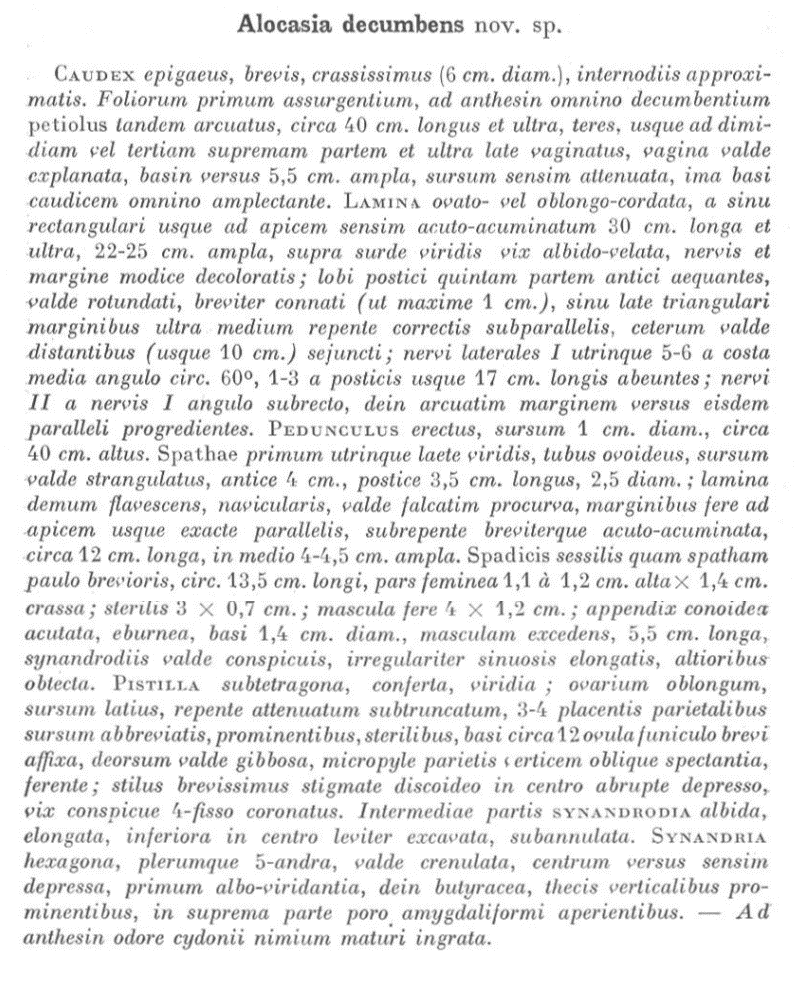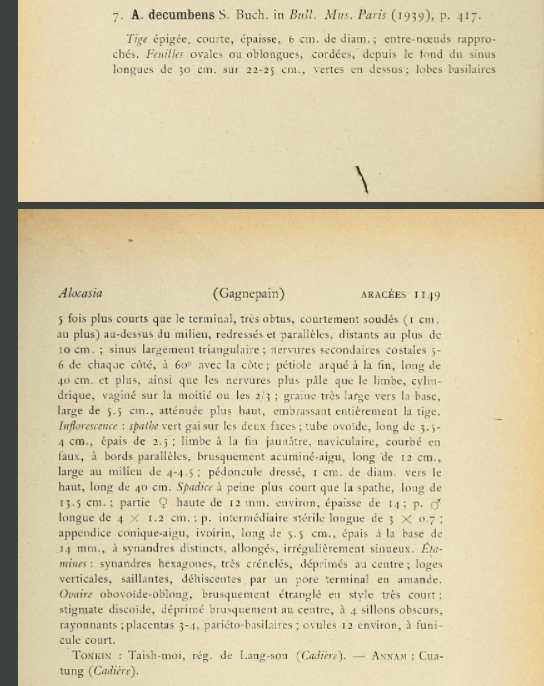ALOCASIA DECUMBENS
ORIGINAL DESCRIPTION:
“Above ground stem is short, 6 cm in diameter at its thickest point. Tight internodal spacing. The leaves point upwards at first, and after anthesis the petioles curve. Petioles are about 40 cm tall, and smooth, even at the top, and wider at the bottom; base is approximately 5,5 cm in diameter, large and stately, gradually attenuated at the bottom of the base of the trunk. Leaf is ovate- or oblong-cordate with a sharp-pointed peak, 30+ cm. long, 22-25 cm. wide, dull whitish-green in color with thin veins and slightly discolored margins; lobes are approximately a fifth of the leaf, rounded, and very briefly connate (at most 1 cm.). Sinus is wide with triangular edges, and becomes parallel towards the top of the lobes, with an interlobar distance of 10 cm; 5-6 lateral veins, which form an angle of about 60° with the central vein, 1-3 back veins up to 17 cm. long; secondary veins angled at less than 90° from the lateral veins and arch, parralel to teach other towards the marginal vein.
The peduncle is erect, and about 1 cm. in diameter, and 40 cm long. The spathe is light green at first, ovoid tubular, very tight, 4 cm long anteriorly and 3.5 cm long posteriorly, 2.5 cm in diameter; after anthesis the spathe is about 12 cm long, 4-4.5 cm wide, with winding curved edges, and becomes almost parallel to the ground. Sessile spadix, about 13,5 cm long, with the female zone 1.1-1.2 cm long and 1.4 cm thick; the sterile mid zone is about 3 cm long and 0.7 cm thick ; the male zone is about 10 cm long and 1.2 cm thick; the appendix is cone shaped, ivory in color, and 5.5 cm long and 1.4 cm thick, synandrous, irregularly winding.
Tetragonal pistils, crowded, with green back; oblong ovary, which extend above, 12 ovules inserted on the 3-4 parietal placentas. Middle sterile part (synandrodium) is white, and elongated, slightly lower than the center of the spadix. The male zone (synandria) is hexagonal, usually 5-lobed, and is white-green at first, then buttery-yellow. Vertical protruding theca, almond colored. The scent of the inflorescence at anthesis is insignificant”
Described in 1939 by Samuel Buchet based on collected material by Léopold Michel Cadière (often cited as R.P. Cadière, where R.P. stands for Révérend Père, a French honorary title for a reverend) in May 1938
Bulletin du Muséum national d'histoire naturelle (France) ser.2:t.11 (1939)
SYNONYMS: N/A
DISTRIBUTION: Vietnam | From Lạng Sơn Province (NE Vietnam) to Thừa Thiên Huế Province (Central Vietnam)
CLIMATE: Ranging from Tropical (rainforest and savannah) in central Vietnam, to temperate (dry winter, hot summer) in NE Vietnam
Humidity is moderately high throughout the year, ranging from 75% to 85%
Temperature across the northern half of Vietnam can vary, generally staying within the range of 50°F/10°C to 86°F/30°C throughout the year
High rainfall during monsoon months (Jun-Sep: can be as high as 2,400 millimeters) and an average of 30 millimetres monthly in the dry season, depending on locality.
SOIL: Areas where Alocasia decumbens has been observed are predominantly limestone, with interbedded sandstone, siltstone and clay shale.
SPECIES DESCRIPTION: N/A
INFLORESCENCE: N/A
VARIEGATED FORMS: N/A


